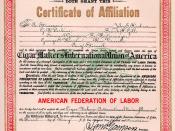Labor Unions
Since the foundation of the American Federation of Labor(AFL) in 1886, most unions in the united States have displayed a pragmatic out look, largely compatible with that of business. The general purpose of unions has been to protect and advance the well being of workers, while that of business has been to promote the interests of stockholders. Higher wages and higher profits are compatible over the long run in a growing economy. Conflict does arise, however, from the fact that in the short run higher wages for workers imply lower profits for shareholders. Power, too, is a matter of dispute. In the absence of unions, managers have a monopoly of power over their employees. With unions on the scene, that power must be shared.
The standard economic analysis of what gave a particular union the power to raise the pay and benefits of its members was propounded by the eminent English economist Alfred Marshall toward the end of the 19th century.
Marshall theorized that the strength of a union depended upon four factors. First, demand for the product should be inelastic, so that there is little, if any, decline in sales in response to price increases. Second, labor costs should be a small portion of the total costs of production, so that a rather large increase in wages would generate only a small increase in the price of the product. Third, the supply of factors that can be used as substitutes for union labor, such as nonunion labor or labor-saving machinery, should be inelastic, so that their price rises substantially as more units are employed. Fourth, the ability of these factors to substitute for union labor should be highly limited; it would be hard to substitute for workers with very high skills or skills that are highly...



Needs a bit more
There is a lot lacking in this essay, and it could be used as a base, or getting ideas from. This essay needs to be more clear.
4 out of 4 people found this comment useful.